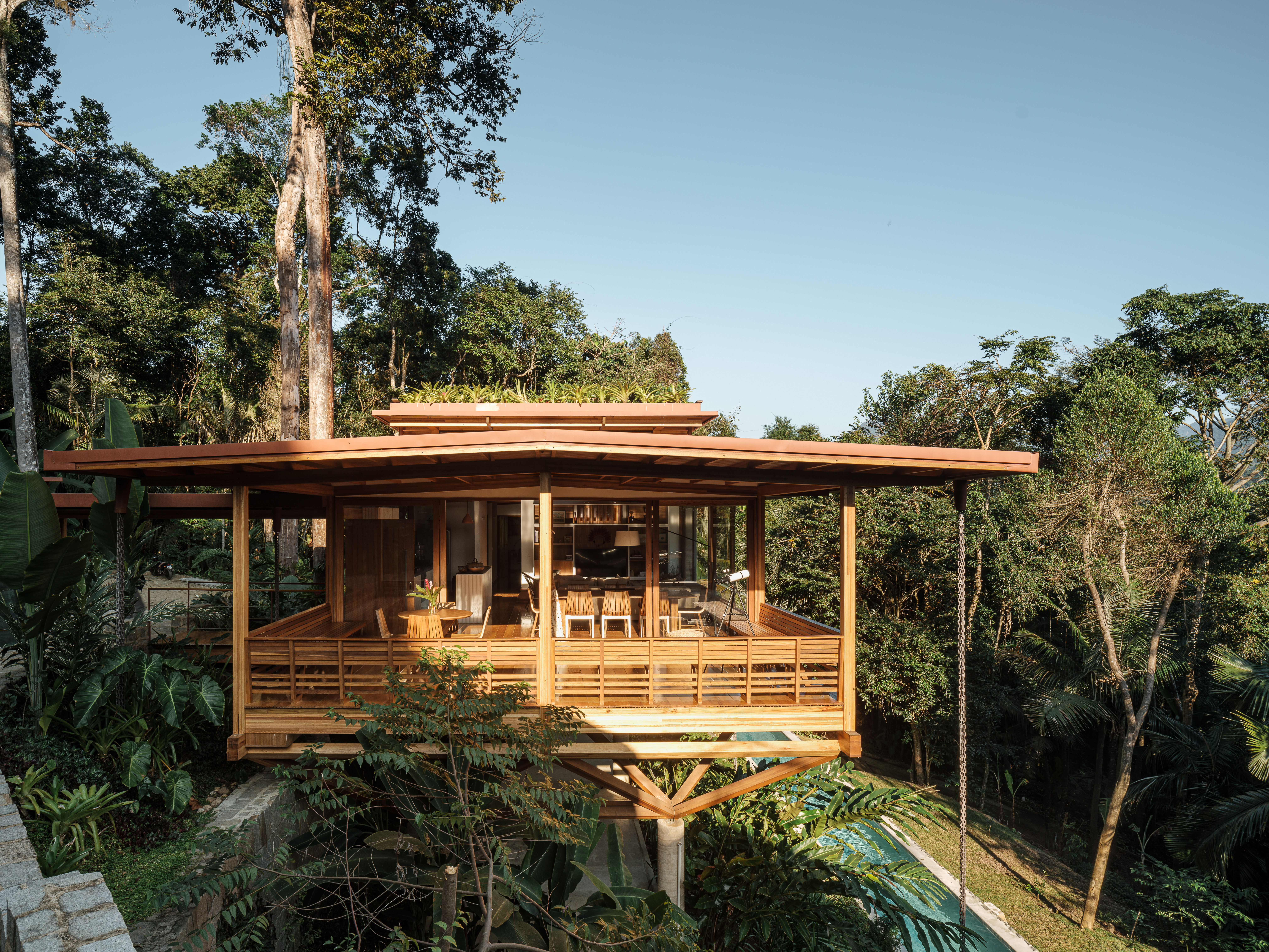
Casa Quinta is designed to float like a boat at canopy level; a private home in the heart of one of the last remaining stretches of Brazil’s coastal rainforest, the Mata Altantica.
The home sits perched at 100m above sea level on the outermost reaches of the picturesque colonial town, Paraty, where the landscape climbs dramatically upwards to the lush flora and fauna of the Mata Atlantica. The tropical rainforest used to extend for thousands of miles in the south-east of Brazil but now only preserves 10 per cent of its former glory.

Explore Casa Quinta by Brazilian studio Arquipelago
The town and the forest are both heavily protected and have been declared Unesco World Heritage Sites, requiring the architects to tread lightly when drawing up plans for the single-storey house situated on a rocky outcrop that peeks out of the jungle as the forest descends to the ocean.
The challenges of building in such a thriving ecosystem required Arquipélago to think carefully about the house’s footprint, opting to build the main house on a wooden structure built on eight stilts, supported by the rock and concrete columns. It is connected to a service extension that preserves the original layout of the towering trees on the site.

'The construction challenges, whether in transporting materials or executing and implementing [plans] on-site, led to a lightweight architecture using industrialised wood to facilitate the desire for a single-storey house in this sloped context, supported by just a few points on the ground,' says one of Arquipélago’s two founders, Luis Tavares.
'The building was designed in a logical, sequential manner within a geometric structure, contrasting with the natural surroundings: four triangulated beams form spatial pyramids, organising the base for the continuation of the structure with beams and columns. These beams were assembled on-site, laid on the ground, and raised onto concrete pillars.'

Elevated above the ground to create views of the forest, the house is accessed by a walkway from the highest point to the rear.
Isolated from the town but enveloped by the forest, the simple single-storey, three-bedroom layout of the house was designed for an elderly woman and her friends and family.

'The main part of the house resembles a boat floating above the forest, static at 100m above sea level. The bedroom functions as the cabin of a captain at the bow of the boat,' says Tavares.
The bedrooms face outwards, with shutters that allow the house to open up to the verdant forest surroundings.

The house’s structure was formed by glue-laminated eucalyptus timber, engineered and manufactured in São Paulo, then transported to the site and assembled to give Arquipélago more control over the execution in the remote location.
The stilts helped elevate the house from the humid floor of the forest but the choice of material required a series of design strategies to produce the final, seemingly effortless, result.

The timber frame was enclosed by lightweight drywall partitions chosen in response to the difficulty of access to the site and set back from the overhanging eaves of the roof; these gestures protect the house from the humidity of its setting.
Furniture and fittings throughout reflect the choice of working with wood, with timber benches and chairs throughout. The bathroom also plays with the verdant surroundings, its peppermint tiles blending into the forest backdrop. Meanwhile, a narrow swimming pool traps water from the roof at the lowest point of the steeply inclined plot.

The project marks a break from the studio’s previous work in the interior of São Paulo state, where it has garnered a following and received awards for its earthy brand of architecture, working on modular designs for houses that often deploy pressed earth in their construction.
Based in São Paulo and Paraty, Arquipélago was formed in 2013 by Tavares and Marinho Velloso, and it recently completed the refurbishment of a cinema in the historic centre of Paraty, which led to the opportunity to create Casa Quinta.

'We always approach our projects with a kind of analysis of the specific context, seeking a solution that fits best. In this case, we aimed to disturb the ground as little as possible, hence the stilts.'
Building a lightweight house able to endure the testing conditions without disturbing the ecosystem resulted in a striking yet harmonious interaction with the jungle. ‘I like the contrast between the rigorous forms of human construction and the natural landscape, that is, the entire geometry of the house's structure alongside the natural forms of the adjacent forest, this relationship between geometry and nature,' says Tavares.

At Casa Quinta, the structure is predominantly built in locally sourced stone and wood. The textured limewashed walls and green envelope of the abundant nature on site add a tactile dimension to the composition.







